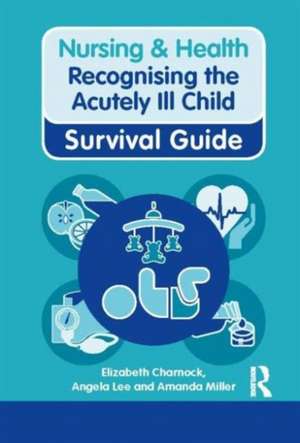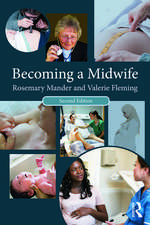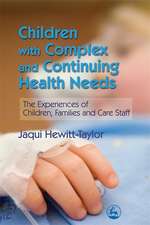Recognising the Acutely Ill Child: Nursing and Health Survival Guides
Autor Elizabeth Charnock, Angela Lee, Amanda Milleren Limba Engleză Paperback – 5 sep 2012
The Nursing & Health Survival Guides have evolved - take a look at our our app for iPhone and iPad.
Din seria Nursing and Health Survival Guides
- 5%
 Preț: 55.81 lei
Preț: 55.81 lei - 5%
 Preț: 64.97 lei
Preț: 64.97 lei - 5%
 Preț: 72.53 lei
Preț: 72.53 lei - 5%
 Preț: 65.06 lei
Preț: 65.06 lei - 5%
 Preț: 65.10 lei
Preț: 65.10 lei - 5%
 Preț: 64.97 lei
Preț: 64.97 lei -
 Preț: 68.62 lei
Preț: 68.62 lei - 5%
 Preț: 64.77 lei
Preț: 64.77 lei - 5%
 Preț: 64.77 lei
Preț: 64.77 lei - 5%
 Preț: 64.77 lei
Preț: 64.77 lei - 5%
 Preț: 64.77 lei
Preț: 64.77 lei - 5%
 Preț: 64.77 lei
Preț: 64.77 lei - 5%
 Preț: 65.37 lei
Preț: 65.37 lei - 5%
 Preț: 65.16 lei
Preț: 65.16 lei - 5%
 Preț: 65.12 lei
Preț: 65.12 lei -
 Preț: 68.40 lei
Preț: 68.40 lei - 5%
 Preț: 64.77 lei
Preț: 64.77 lei - 5%
 Preț: 64.97 lei
Preț: 64.97 lei - 22%
 Preț: 53.68 lei
Preț: 53.68 lei - 5%
 Preț: 64.98 lei
Preț: 64.98 lei - 23%
 Preț: 52.57 lei
Preț: 52.57 lei
Preț: 64.77 lei
Preț vechi: 68.19 lei
-5% Nou
Puncte Express: 97
Preț estimativ în valută:
12.40€ • 12.66$ • 10.44£
12.40€ • 12.66$ • 10.44£
Carte disponibilă
Livrare economică 05-19 februarie
Livrare express 21-25 ianuarie pentru 11.45 lei
Preluare comenzi: 021 569.72.76
Specificații
ISBN-13: 9780273763727
ISBN-10: 0273763725
Pagini: 54
Dimensiuni: 80 x 120 x 8 mm
Greutate: 0.04 kg
Ediția:New.
Editura: Taylor & Francis
Colecția Routledge
Seria Nursing and Health Survival Guides
Locul publicării:Oxford, United Kingdom
ISBN-10: 0273763725
Pagini: 54
Dimensiuni: 80 x 120 x 8 mm
Greutate: 0.04 kg
Ediția:New.
Editura: Taylor & Francis
Colecția Routledge
Seria Nursing and Health Survival Guides
Locul publicării:Oxford, United Kingdom
Cuprins
INTRODUCTION: THE IMPORTANCE OF EARLY
RECOGNITION OF ACUTE ILLNESS IN CHILDREN
KEY PRINCIPLES OF PHYSICAL ASSESSMENT
Standards for assessing and measuring physiological observations
Temperature
Pulse and respiration
Blood pressure
Recording physiological observations
The limitations of Early Warning Scores (EWS)
The importance of parental observations
CHILDREN ARE DIFFERENT FROM ADULTS
Pre-terminal signs
Anatomical and physiological differences between children and adults
A structured approach to assessment
ASSESSMENT OF AIRWAY (A)
Is the airway open?
Are there any added sounds which may indicate airway difficulties?
Airway adjuncts
ASSESSMENT OF BREATHING (B)
Effort of breathing
Efficacy of breathing
Effects of breathing inadequacy on other organs
Respiratory severity assessment
Oxygen delivery adjuncts
ASSESSMENT OF CIRCULATION (C)
Heart rate
Pulse volume
Pulse rhythm
Capillary refill time (CRT) and body temperature
Blood pressure
Recognising the shocked child
Classification and causes of shock
The three stages of shock
Meningococcal septicaemia: signs and symptoms
Recognising the dehydrated child
Calculation of fluid requirements
ASSESSMENT OF DISABILITY (D)
Rapid assessment of disability: AVPU
Posture
Pupils
Causes of raised intracranial pressure
Signs of raised intracranial pressure
Seizures
‘Don’t ever forget glucose’: DEFG
Tips to promote accurate measurement and recording of neurological observations
Contraindications to performing a lumbar puncture
ASSESSMENT OF EXPOSURE (E)
Rashes and bruising
Temperature
APPENDIXES
1 Physiological observations: normal ranges and estimation of weight formula
2 Paediatric SBAR tool
3 Basic life support – paediatric algorithm
4 Paediatric FBAO treatment algorithm
REFERENCES
USEFUL WEBSITES
RECOGNITION OF ACUTE ILLNESS IN CHILDREN
KEY PRINCIPLES OF PHYSICAL ASSESSMENT
Standards for assessing and measuring physiological observations
Temperature
Pulse and respiration
Blood pressure
Recording physiological observations
The limitations of Early Warning Scores (EWS)
The importance of parental observations
CHILDREN ARE DIFFERENT FROM ADULTS
Pre-terminal signs
Anatomical and physiological differences between children and adults
A structured approach to assessment
ASSESSMENT OF AIRWAY (A)
Is the airway open?
Are there any added sounds which may indicate airway difficulties?
Airway adjuncts
ASSESSMENT OF BREATHING (B)
Effort of breathing
Efficacy of breathing
Effects of breathing inadequacy on other organs
Respiratory severity assessment
Oxygen delivery adjuncts
ASSESSMENT OF CIRCULATION (C)
Heart rate
Pulse volume
Pulse rhythm
Capillary refill time (CRT) and body temperature
Blood pressure
Recognising the shocked child
Classification and causes of shock
The three stages of shock
Meningococcal septicaemia: signs and symptoms
Recognising the dehydrated child
Calculation of fluid requirements
ASSESSMENT OF DISABILITY (D)
Rapid assessment of disability: AVPU
Posture
Pupils
Causes of raised intracranial pressure
Signs of raised intracranial pressure
Seizures
‘Don’t ever forget glucose’: DEFG
Tips to promote accurate measurement and recording of neurological observations
Contraindications to performing a lumbar puncture
ASSESSMENT OF EXPOSURE (E)
Rashes and bruising
Temperature
APPENDIXES
1 Physiological observations: normal ranges and estimation of weight formula
2 Paediatric SBAR tool
3 Basic life support – paediatric algorithm
4 Paediatric FBAO treatment algorithm
REFERENCES
USEFUL WEBSITES
Notă biografică
Elizabeth Charnock, Angela Lee, Amanda Miller
Descriere
Early and accurate recognition of an acutely ill child is essential. Ideal for quick reference, this pocket-sized guide puts all the crucial information at your fingertips.
The Nursing & Health Survival Guides have evolved - take a look at our our app for iPhone and iPad.
The Nursing & Health Survival Guides have evolved - take a look at our our app for iPhone and iPad.













